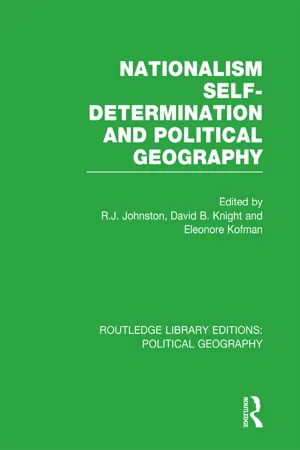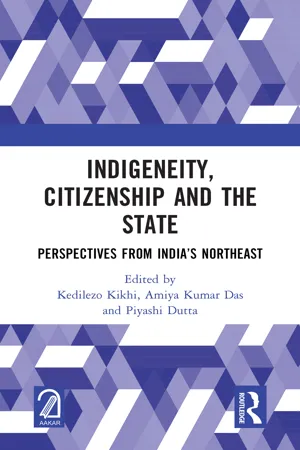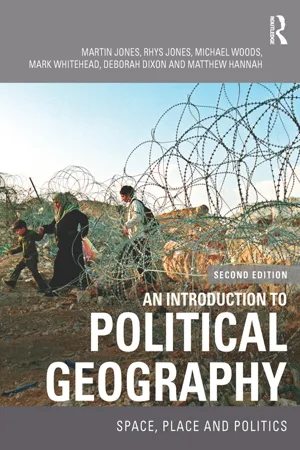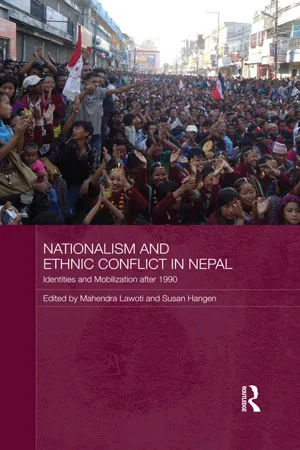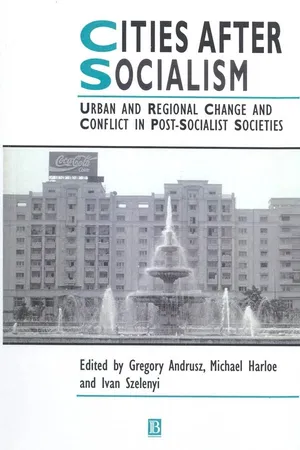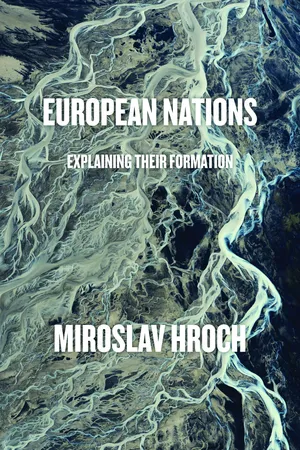Geography
Ethnic Nationalist Movement
The ethnic nationalist movement refers to a political and social movement driven by the desire to establish or maintain a separate identity and political autonomy for a specific ethnic group. It often involves the promotion of cultural, linguistic, and historical distinctiveness, and can lead to demands for self-determination or independence. This movement is shaped by the unique geographical and historical context of the ethnic group.
Written by Perlego with AI-assistance
Related key terms
8 Key excerpts on "Ethnic Nationalist Movement"
- R. J. Johnston, David Knight, Eleonore Kofman(Authors)
- 2014(Publication Date)
- Routledge(Publisher)
In many autonomist and separatist nationalisms (post-colonial and old-state), much effort is devoted to constructing a nation out of what are in reality disparate communities and classes. Nationalism offers an ideological focus for territorial, social and political unity, where previously none existed, or had ceased to exist. Interpretations in terms of internal colonialism and national liberation have been shared by movements in different parts of the world, with European movements comparing their relationship to the centre, and even strategies for liberation, with Third World liberation struggles. Of course, the fundamental question to be asked is why different types of nationalist (sub-state) movements should be seeking to mobilise a population within a given territory, whose boundaries are not necessarily fixed.In Summary
The essays in this book have been assembled to help us advance the understanding of a major issue in the contemporary map of the world. That understanding requires two linked spheres of activity. The first is the development of a coherent overarching framework, or mode of analysis, that allows us to appreciate the general nature of nationalism and its associated concept of self-determination. The other is the elucidation of particular nationalisms, thereby to increase our awareness of the detailed nature of such social and political movements and their geographical and historical contexts. The two types of work feed off each other; the overall framework enhances the understanding of particulars, whereas the latter enables the framework to be more substantially constructed.All of the essays in this book have been written by geographers. Their discipline has no exclusive claim to the study of nationalism. What the essays demonstrate very clearly, however, is that nationalism is a form of social and political movement firmly rooted in territory, in place and space. Nationalist movements do not just operate territorially, they interpret and appropriate space, place and time, upon which they construct alternative geographies and histories. All too often, writing on nationalism has passed over the significance of territory in nationalist ideologies, politics and strategies.- eBook - ePub
The Politics of Ethnicity in Pakistan
The Baloch, Sindhi and Mohajir Ethnic Movements
- Farhan Hanif Siddiqi(Author)
- 2012(Publication Date)
- Routledge(Publisher)
First, emotions or emotive appeal are context dependent. Political mobilisation within an ethnic group is not a function of emotions as emotions are not a cause but an effect. The cause of heightened emotions are related to conditions of domination, neglect and isolation which an ethnic group perceives subjectively (which Connor ignores) and then embarks upon creating a political voice in response to such conditions. When the political voice gains momentum, emotions related to group feelings of unity based on common descent, kinship and blood ties etc., are consequently aroused. Thus, it is not emotions which dictate political mobilisation, it is the political conditions which intensify emotions and lead to the creation of an ethnopolitical movement. It is safe to assume that as citizens of the modern nation-state, all ethnic groups are affected by decisions of the central decision-making authority and that such decisions have a significant effect in both attenuating as well as intensifying the feelings of ethnonationalism.Second, a more powerful and persuasive explanation of the rise of nationalism in both the developed and developing world has to do not with the emotive appeal of ethnonationalism, but rather its ideological prowess as a doctrine of resistance authenticated and legitimated by the international community and exemplified in President Woodrow Wilson’s Fourteen Points.17 In the twentieth century, and especially since the First World War, the idea of nationalism and national self-determination spread into every nook and cranny of the world engendering an incipient basis of anti-colonial nationalism which brought down colonial powers and their rule.18 Nationalism, according to such an interpretation, then qualifies as an ideology of resistance or as a legitimate organising principle of politics which nations and ethnic groups espouse in order to claim rights and thwart oppression. In the words of Benedict Anderson:The reality is quite plain: the ‘end of the era of nationalism,’ so long prophesied, is not remotely in sight. Indeed, nation-ness is the most universally legitimate value in the political life of our time.19Nationalism as an ideology and political principle in the developing world came primarily through the colonial state. This subject is an important part, yet unfortunately, an understated strand of a brilliant work on nationalism by Benedict Anderson. The most profound and the most commented on, debated and analysed bit concerns Anderson’s emphasis on the rise of modern industrial technology (capitalism), its associated industry relating to vernacular press (print-capitalism) and through the latter the eradication of communication barriers between people living within a territory. The Enlightenment, according to Anderson, played a key role in the development of nationalism, as ecclesiastical authority lost its hegemony which signalled the collapse not only of religion but also of its associated language, Latin. The Latin language was now replaced with a vernacular language and coupled with the rise of print-capitalism it heralded the rise of nationalism as communication barriers broke down and people began to ‘imagine’ themselves as a nation. According to Anderson, the driving classes behind nationalism were the educated bourgeoisie who ‘were the first classes to achieve solidarities on an essentially imagined basis’.20 - eBook - ePub
Indigeneity, Citizenship and the State
Perspectives from India's Northeast
- Kedilezo Kikhi, Amiya Kumar Das, Piyashi Dutta(Authors)
- 2023(Publication Date)
- Routledge(Publisher)
12 Nationalism and Social Exclusion: The Making of Ethnic Identity Movements in Assam Ransaigra Daimary The modern Indian polity has witnessed a series of popular ‘ethnic’ movements from amongst its various ‘ethnic’ constituents, particularly over the question of ‘self-rule’ even though what this term actually means for both the state and the representatives of the movements remains ambiguous (Sharma, 2005, p. 31). The meaning of the term ‘self-rule’ has historically varied from the desire for differing degrees of autonomy within the Indian union to the demand for a sovereign state outside India. Post-colonial India has faced separate state movements based on separate ethnic and linguistic lines since the 1950s, for example, the Samyukta Maharashtra Movement, the Dravida Movement, the Naga Movement, etc. However, according to Sharma (2005, p. 31), irrespective of the actual content of the demand for self-rule, there has been an upsurge in the number of these movements since the 1960s. It seems the ethnic identity movements problematises the seemingly homogeneous, although, imagined community of the Indian nation. In this line, Dipankar Gupta (1997, p. 228) argues that ethnic movements are the outcome of a nation-building exercise undertaken by the multi-ethnic Indian state. While contested by thinkers such as Eugen Weber who in his work, Peasants into Frenchman: The Modernization of Rural France 1870-1914 (1976), argues that the Indian nation state was unable to adopt the Western model of the nation state, where ideally, language, religion and political sovereignty had coterminous boundaries, though this can be contested. While Indian nationalists aim at creating a pan-Indian character, it proved to be illusory, as diverse cultural, linguistic, and regional groups begin resisting the dominant identity - eBook - ePub
Ethnicity, Nationalism and Violence
Conflict Management, Human Rights, and Multilateral Regimes
- Christian P. Scherrer(Author)
- 2017(Publication Date)
- Routledge(Publisher)
In fact, research into the causes of conflict seeks, for analytical purposes, to highlight the conditions under which collective identities and potentials for mobilization emerge. 22 Ethno-nationalism is one of the most contradictory and complex political ideologies of contemporary times. A distinction should be drawn between: 1) ethno-nationalism from below, which sees itself as a civilian political, social, or cultural liberation movement or as an armed movement of resistance against the persecution and endangerment of an oppressed nation/nationality; and 2) destructive ethno-nationalism from above, as part of state strategies designed to consolidate the power of dominant ethnic groups. Concepts of tribalism, by contrast, are mostly (post-) colonial fabrications, which overlook the fact that ethnicity and ethno-nationalism (particularly in its militant form) are modern concepts and ideologies that contradict the notions of primitivity and backwardness often associated with it. Hence, ethnicity and ethno-nationalism might well be bearers of progressive contents that represent a rational answer to a perceived or real threat. Evidence of the functionality and relativity of ethno-nationalism offered by contemporary examples demonstrates that ethnic-cum-national patterns of thinking and action are not quasi-natural, unchanging historical phenomena but develop from specific social constellations and power-political situations. 23 Ethno-nationalism as an Element in the World Order False thesis No. 3: The Cold War has given way to a 'new chaos'. 'Chaos power' is gaining ground, often in 'ethnicized' form. Internal wars have taken the place of inter-state wars as the crucial destabilizing factor in the global order. 24 Within the model of the world of states and the societal world, societal actors have a 'chaoticizing' effect - eBook - ePub
An Introduction to Political Geography
Space, Place and Politics
- Martin Jones, Rhys Jones, Michael Woods, Mark Whitehead, Deborah Dixon, Matthew Hannah(Authors)
- 2014(Publication Date)
- Routledge(Publisher)
Furthermore, an important element within nationalism is the belief that every nation should possess its own sovereign territory or state. The ideology and political practice of nationalism therefore seeks the ideal political and territorial scenario of the nation-state, in which every citizen of the state is a member of the same nation. Thinking of this in geographical terms, nation-states represent political geographies in which the boundary of the nation coincides with the boundary of the state (Gellner 1983: 1). Obviously, in a world characterised by continuous flows of people, the ideal of the nation-state is precisely that – an ideal that can never be achieved. Indeed, it has been famously argued by Mikesell (1983) that the only example of a nation-state in the contemporary world is Iceland. Unfortunately, the difficulties in achieving the goal of the nation-state do not stop states, nations and minority groups from trying – sometimes peaceably and sometimes violently – to reach the ideal. Examples such as the attempts to create an independent Quebec through referenda and the terrorism of ETA, the Basque separatist movement in Spain, demonstrate the salience of such processes within contemporary political geography. We now possess an understanding of what nations are, along with some of the ideologies that are linked to them. The key question that has exercised the minds of social scientists and historians in the field of nationalism is ‘How are nations formed and continue to exist?’ To put it another way, ‘How are nations reproduced?’ We want to distinguish here between two major categories of theories of nationalism. A set of classical theories of nationalism has sought to examine the longer-term processes, which have contributed to the emergence both of nationalism as an ideology and of specific nations - eBook - ePub
Nationalism and Ethnic Conflict in Nepal
Identities and Mobilization after 1990
- Mahendra Lawoti, Susan Hangen(Authors)
- 2012(Publication Date)
- Routledge(Publisher)
Contextualizing nationalism and ethnic conflictFigure 0.1 Topographic map of Nepal. Prepared by Milan ShresthaFigure 0.2 Caste/Ethnographic map of Nepal: Prepared by Bal Krishna MabuhangPassage contains an image
1Introduction
Nationalism and ethnic conflict in NepalSusan Hangen and Mahendra LawotiThe decade long Maoist armed conflict formally came to an end in 2006 with the peace settlement between the government of Nepal and the rebels, but ethnic mobilization and conflicts, which surged forward in Nepal after the restoration of democracy in 1990, have further increased since 2006. The largely peaceful identity movements of the 1990s became more violent after the turn of the century: an organization of indigenous nationalities launched an armed insurgency in the late 1990s in the eastern hills, and dozens of armed groups have arisen in the hills and Tarai after the turn of the century.These movements, based on ethnicity, language, caste, religion, and regional identity, have become increasingly central players on the contemporary political stage, reshaping debates on the definition of the Nepali nation, nationalism and the structure of the Nepali state. Members of the traditional dominant group still lead the polity but they can no longer ignore marginalized identity groups. In fact, groups like the Madhesis have begun to wield disproportionate power in the making and unmaking of the governments and in coalitional politics after the 2008 election. This volume describes these identity movements and their evolution in the two decades following the 1990 People’s Movement.This book represents the first comparative analysis of identity-based movements in Nepal. It contains chapters on the Madhesi (regional, linguistic), Muslim (religious), Dalit (caste) and indigenous nationalities (linguistic, ethnic, religious) movements as well chapters that compare the movements. By analyzing these diverse movements within a single volume, and within some chapters in the volume, we aim to provide data to allow for the methodologically rigorous production of generalizations about the formation of movements and the differences between movements. - eBook - ePub
Cities After Socialism
Urban and Regional Change and Conflict in Post-Socialist Societies
- Gregory Andrusz, Michael Harloe, Ivan Szelenyi(Authors)
- 2011(Publication Date)
- Wiley-Blackwell(Publisher)
reactive nationalism . According to some thinkers, class and ethnic conflicts accumulate more frequently in Eastern than Western Europe because, in the case of the former, the various ethnic groups have not such clearly defined territorial boundaries (Gellner, 1969; Hechter, 1975). Thus, in this view those who actively mobilize are not to be seen as undeveloped ‘hillbillies’, incapable of modernizing and nation-building. Members of the dominant nation have penetrated the life sphere of the sub-nation (as did the Italians in South Tyrol), and its (regional) economy has been made into an appendix of the national economy. The economic life-chances of classes and ethnic groups are distorted, making conflicts seemingly inevitable.Reactive nationalism develops most frequently in areas where the economy is in decline. In some cases, such as in Belgium, the two major ethnic groups compete in nationalistic terms, Wallonia was once the industrial centre but later declined to a ‘black country’. The Flemish-speaking parts, on the other hand, developed from being agrarian-based into the loci of modern industries. Then in the 1980s the former dominant group, the Walloons, began to feel like a suppressed minority. Nevertheless, the now dominant ethnic group, the Flemings, retained their militant, nationalist attitude since they felt culturally inferior. It is possible that the Ukraine might develop along this path.Reactive nationalism can be linked to a model of ethnic competition. Modernization does not extinguish feelings of national identity. On the contrary, it is only when modernization has succeeded in overcoming family and parochial loyalties that sub-nations are able to begin discovering their identity. Ethnic mobilization is more important than is suggested by deterministic, evolutionary theories of the modernization process, which assume that history takes its inevitable course. Mobilization occurs when the pressure of the forces of modernization give rise to competition between identifiable ethnic units for jobs, housing and other benefits.For political scientists who have an interest in actors and not only in autopoietic processes of self-development, a resource approach - eBook - ePub
European Nations
Explaining Their Formation
- Miroslav Hroch, Karolina Graham(Authors)
- 2015(Publication Date)
- Verso(Publisher)
While this type of scholar can also be found among the non-ruling ethnic groups, they tended to be private individuals and did not appear until the era of enlightened patriotism. It should be remembered that this scholarly ‘phase A’ only ever had a faint presence in some cases – for example, in the Serbian, Belarusian and Basque national movements – and that at times the epicentre of scholarly interest lay partly outside the ethic group’s territory (for example, in Lithuania and Greece). Moreover, it holds true for national movements – but not only for them – that erudite patriots did not necessarily come from the ethnic group to which they devoted their scholarly efforts. A closer examination will reveal that their scholarly interest was usually accompanied by an emotional interest in the subject, as was typical of all Enlightenment scholars. Although their studies were an important prerequisite to the formation of a concept of the modern nation, it would be an ahistorical update if we asserted that it was each of these scholars’ subjective intention to pave the way for or initiate a national movement. The determination to learn about the distinctive features of an ethnic group only occasionally went hand-in-hand with the vision of its further development towards a nation.In the narrower sense of the word, ‘national’ movements came into being as soon as several members of an ethnic group – usually those who had had access to higher education – decided to spread national awareness and offer a new national identity, presenting it as something of a specific value and a commitment for all members of the group. In most cases the focus was on cultural, linguistic and social goals, but at times political demands were added too (for example, by the Norwegians, the Irish and the Greeks). ‘Phase B’ rarely progressed as a linear correlation between agitation and mass mobilisation. Being limited to a small circle of patriots, it initially acted in something of a social vacuum. In time, however, there was a shift in attitudes, and calls for patriotism gained wider appeal.The question is whether or not state-nations underwent a parallel phase to the ‘phase B’ of national movements, during which, as has been mentioned, the success of nation-building usually took on the form of an intra-state struggle for political and civic rights. Whether it occurred as a revolution or as gradual reforms, it was always a struggle of active minorities, who provided political and cultural coordinates for the forming nation. Once these coordinates were established as more or less consistent and indisputable, efforts to mobilise the masses took place. The intensity of these efforts corresponded with the degree to which the new power elites felt they needed to reinforce their power within ‘their’ state and/or with their growing interest in defensive, expansive or even war politics. In state-nations, the power struggle was an intrinsic part of national mobilisation from the very beginning. However, the success of the nation-building processes in these nations was clearly not dependent on mass mobilisation.
Index pages curate the most relevant extracts from our library of academic textbooks. They’ve been created using an in-house natural language model (NLM), each adding context and meaning to key research topics.
